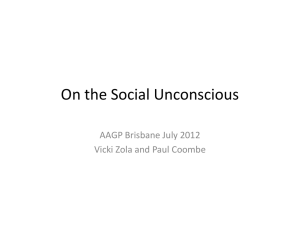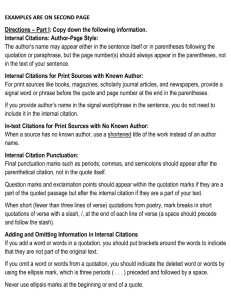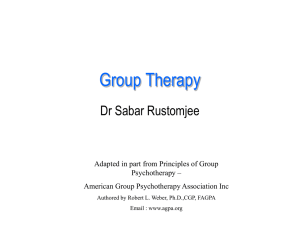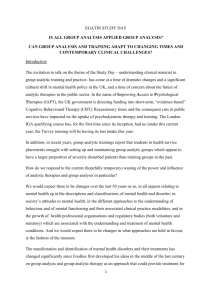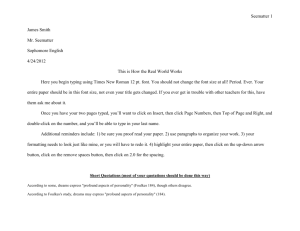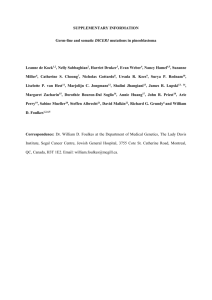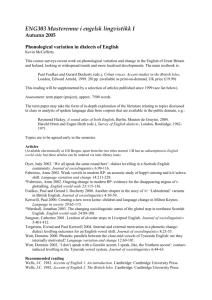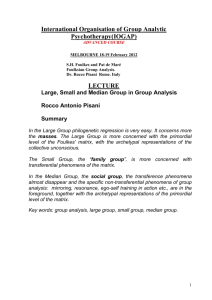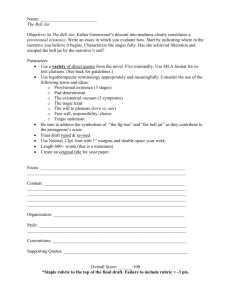The foundation matrix - a useful fiction
advertisement
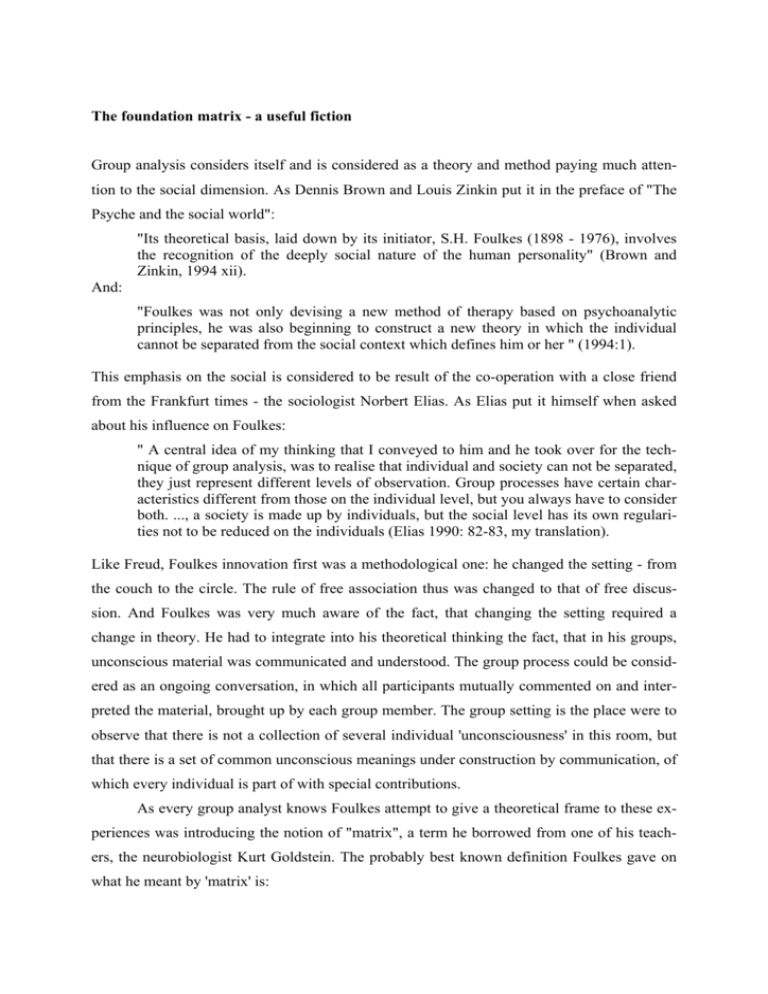
The foundation matrix - a useful fiction Group analysis considers itself and is considered as a theory and method paying much attention to the social dimension. As Dennis Brown and Louis Zinkin put it in the preface of "The Psyche and the social world": "Its theoretical basis, laid down by its initiator, S.H. Foulkes (1898 - 1976), involves the recognition of the deeply social nature of the human personality" (Brown and Zinkin, 1994 xii). And: "Foulkes was not only devising a new method of therapy based on psychoanalytic principles, he was also beginning to construct a new theory in which the individual cannot be separated from the social context which defines him or her " (1994:1). This emphasis on the social is considered to be result of the co-operation with a close friend from the Frankfurt times - the sociologist Norbert Elias. As Elias put it himself when asked about his influence on Foulkes: " A central idea of my thinking that I conveyed to him and he took over for the technique of group analysis, was to realise that individual and society can not be separated, they just represent different levels of observation. Group processes have certain characteristics different from those on the individual level, but you always have to consider both. ..., a society is made up by individuals, but the social level has its own regularities not to be reduced on the individuals (Elias 1990: 82-83, my translation). Like Freud, Foulkes innovation first was a methodological one: he changed the setting - from the couch to the circle. The rule of free association thus was changed to that of free discussion. And Foulkes was very much aware of the fact, that changing the setting required a change in theory. He had to integrate into his theoretical thinking the fact, that in his groups, unconscious material was communicated and understood. The group process could be considered as an ongoing conversation, in which all participants mutually commented on and interpreted the material, brought up by each group member. The group setting is the place were to observe that there is not a collection of several individual 'unconsciousness' in this room, but that there is a set of common unconscious meanings under construction by communication, of which every individual is part of with special contributions. As every group analyst knows Foulkes attempt to give a theoretical frame to these experiences was introducing the notion of "matrix", a term he borrowed from one of his teachers, the neurobiologist Kurt Goldstein. The probably best known definition Foulkes gave on what he meant by 'matrix' is: "The matrix is the hypothetical web of communication and relationship in a given group. It is the common shared ground which ultimately determines the meaning and significance of all events and upon which all communications and interpretations, verbal and non-verbal rest" (Foulkes 1964: 292). Or: "The network of all individual mental processes, the psychological medium in which they meet, communicate and interact, can be called the matrix" (Foulkes and Anthony 1965: 26). Foulkes attempts to describe what is meant by 'matrix' are manifold. The reader still can feel the theoretical effort that is made in trying to find a language for what he experienced in his groups. In trying to conceptualise what happens in between the members of a group Foulkes enters new territory, thus he can be considered as an early representative of a communicative and interactive understanding of the unconscious. He himself enlarged this understanding beyond the rather limited situation of a therapy group by elaborating the notion of matrix at two different levels, the 'dynamic matrix' being the level to be observed under construction in a group analytic group, and introducing the term 'foundation matrix' indicating the level and store of shared communication and meanings proceeding every actual group. Foulkes has put it like this: "Instead, I have accepted from the beginning that even a group of total strangers, being of the same species and more narrowly of the same culture, share a fundamental mental matrix (foundation matrix). To this their closer acquaintance and their intimate exchanges add consistently so that they also form a current, ever moving ever developing dynamic matrix" Foulkes 1990: 228). Elsewhere he included body images, language, social class, and education as elements of the foundation matrix and went on – "What we traditionally look upon as our innermost self, the intrapsychic against the external world, is thus not only shareable, but is in fact already shared" (Foulkes 1975: 62). Here we have a revolutionary turn in thinking: the innermost, the most private, is already in common, is based on shared ground. No place is left for "a social" that is somehow added to "the individual". With the notion of the foundation matrix Foulkes went into the centre of the old hermeneutic question "Why do we understand, when we understand?" But as a pioneer Foulkes gave us the questions and first ideas, which doesn't mean, he gave a consistent theory. We are left with the task, to work out and to develop his thoughts. In this context it is interesting that in recent trials to develop group-analytic theory there is much criticism about the notion of the foundation matrix. Dalal calls it "mother nature in disguise" and Stacey is afraid, that a second psychic structure is to be installed and sees a backlash into individualistic thinking. Space does not permit me to go into these arguments at length. But I would say that there is no need to be afraid of "mother nature" in regard to a post-Foulkesian theory of unconscious processes. E.g. nowadays it is known that the expressions of basic affects like fear, anger, disgust, sadness, surprise, interest, happiness are innate and can be communicated and understood very early in life and by all humans (see the work of Ekman and Friesen in the US or Krause in Germany). This indicates a phylogenetic heritage of affect expressions related to our basic capacity and necessity to relate. Furthermore there are findings that even our brains do not develop but in the course of early interactions and that the mutual attuning processes between mother and infant have a clearly physiological site (see Stern 1985). The latest and very exciting finding in that area is the detection of the 'mirror neuron', indicating that mutual action understanding is the common base for communication in all primates. Thus from the very beginning our biology is directed to be social and Foulkes notion of the foundation matrix opens up the possibility to consider human biology as precondition and at the same time an integral part of a theory of the unconscious, that is aware of the 'socialness' at all levels. Concerning Stacey’s apprehensions about the second psychic structure I assume he is addressing not so much Foulkes but Jung, who conceptualised his ‘collective unconscious’ clearly as "...a second psychic system of non personal character" (Jung 1936: 45). And this system and its contents -the archetypes- are considered as inherited. But these ideas are very different from Foulkes notion of the foundation matrix (though in the process of developing this idea he once -1968- referred to Jung, but never came back to it later) as a communicational ground. Thus Foulkes seems to be the wrong addressee for Stacey’s argument. But let me come back the characteristic features of the foundation matrix as mentioned by Foulkes: It is based on biology - the anatomy and physiology of the human species, it includes language, culture and social class. This list is clearly not a systematic one, as Foulkes would not generally be called a systematic thinker. What he is aiming at is to convey an understanding of individuals as well as of society as units consistently under construction by communication. And he focuses our attention to the fact of different communicational levels connected to different time rhythms. He gives us some sort of ranking according to the speed - or better slowness - of time needed for change. Including biology as a level of communication means to consider the body as a biological-social unit, I shall come back to this later. Connected to time rhythms, biology is the slowest moving level, but it is not completely static, as e.g. the fact, that all over the world people get taller, indicates. A clearly flexible level is language, itself part of the slow moving unit of culture. Foulkes does not explain what he considers to be part of a given culture. He just implies that the common biological base belonging to all humans is worked out in different ways by different cultures. Jaak Le Roy elaborated on culture and included e.g. also the family system: "This family group, its members and positions are not universally defined but differ according to the culture to which the family group belongs" (Le Roy in Brown & Zinkin 1994: 183). He further refers to such basic dimensions like – • the understanding of inside and outside the cultural group, • gender relations, • the relationship between the generations. I may add • the whole social structure including social class. And if we include these dimensions, which are relatively stable but clearly open to change, we have included • history and • power. May be the most fascinating fact to study in this context is what Vamik Volkan called the "chosen trauma" in which - seemingly independent of time and space - a historical fact comes in defining the inside and the outside of a group (Volkan 1999). Thus we have depicted what could be the contents of the foundation matrix. Still open is the question of the media of communication related to it. How are these basic dimensions conveyed and understood. Language here is not the solution but part of the problem to be explained. Sometimes the primordial level of communication is linked especially to the foundation matrix. Without questioning the significance of primordial images, which in my opinion arise as a result to basic live situations, that are given to all humans (e.g. birth and death, men and women etc.), at a basic level of symbolisation, I would like to draw your attention into another direction and want to argue in favour of a broader understanding of communication. Though very open to the relevance of non-verbal communication, Foulkes never gave up in his theoretical thinking the primacy of verbal language. But to understand the forms of interaction into which a child is born, we have to enlarge the notion of communication. Following Pierre Bourdieu I would like to emphasise the importance of the body being not only a tool for working, but conveying in a very fundamental sense expression and social meaning. Our bodies never are solely biological but from the very first moment of an individual it is perceived and constituted in all its dimensions at a social level. There is no gesture, no attitude without a social meaning. Bourdieu calls this 'Habitus' (Bourdieu 1982). This means more an order in the body than in the mind. Habitus means embodied social values inevitably acquired through early interactions near to the body in a given social context and thus creating the basis for further perceptions and their evaluations. Consciousness is of lesser importance in regard to these processes. Moreover it transcends the opposition of conscious and unconscious, because most of the phenomena referred to in this context are absolutely not unconscious in the meaning of unknown, but deeply unconscious regarding all the meanings included in the actions, plays, rituals and ritualizations. Here the body itself acts as memory. Following Bourdieu individuals acquire the most basic and fundamental patterns and classifications (as e.g. gender relations, dominance and submission, social class and other group markers, intimacy and distance) through acting and interacting. Thus the concept of the 'Habitus' gives us a possibility to articulate at a sociological level the forms of interactions, the communication patterns and related emotions, ways of perceiving etc. relevant when outlining the foundation matrix. Moreover - connected with the findings of the baby watchers and related theories, that indicate that there is a level 'in between' the level of implicit action knowledge and the verbal representation - it opens up the possibility to get to a theory of the unconscious, that is based on group analytic thinking integrating biology, psychology and sociology. This really is postfoulkesian, because originally the terms 'matrix' or 'foundation matrix' just were metaphors, giving a new idea, a fresh direction of thinking but not being covered by a theory of the unconscious. Nowadays the contours of such a theory begin to shape and I hope I made clear how useful the notion of the foundation matrix is in directing our attention to very fundamental patterns of communication or to the answer of the question: "What do you communicate before saying 'Hallo'?" References Bourdieu, P. (1982): Die feinen Unterschiede: Kritik der gesellschaftlichen Urteilskraft. Frankfurt/M: Suhrkamp Brown, D. and Zinkin, L. (eds) (1994): The Psyche and the Social World. London/New York: Routledge Dalal, F. (1998): Taking the Group Seriously: Towards a Post-Foulkesian Group Analytic Theory. London: Jessica Kingsley Publishers Ekman, P. and Friesen, W.V. (1978): FACS Facial Action Coding System -a technique for the measurement of Facial Movement. Palo Alto: Englewood Cliffs. London: Prentice Hall, 1975 Elias, N. (1990): Norbert Elias über sich selbst. Frankfurt/M: Suhrkamp Foulkes, S.H. (1964): Therapeutic Group Analysis. London: George Allen & Unwin; German (1992): Gruppenanalytische Psychotherapie. München Foulkes, S.H. (1973): The Group as a Matrix of the Individual's Mental Life. In Foulkes, E. (ed) (1990): Selected Papers, 223-233. London: Karnac Books Foulkes, S.H. (1975): A Short Outline of the Therapeutic Processes in Group-analytic Psychotherapy. Group Analysis 8, 1975: 59-63 Foulkes, S.H. and Anthony, E. J. (1965): Group Psychotherapy. Second edition. London Jung, C.G. (1936): Der Begriff des kollektiven Unbewussten. Dtv Taschenbuchausgabe in 11 Bänden in Bd. 6 Archetypen: 45-56 Krause, R. (1983): Zur Onto- und Phylogenese des Affektsystems und ihrer Beziehungen zu psychischen Störungen. Psyche 37, 1015-1043 Le Roy, J. (1994): Group Analysis and Culture. In Brown, D. and Zinkin L. eds. (1994): The Psyche and the Social World. London Stern, D. (1985): The Interpersonal World of the Infant. New York Stacey, R. (2001): What Can it Mean to Say that the Individual is Social Through and Through? Group Analysis Vol. 34, Dec. 2001: 457-471 Volkan, V.D. (1997): Bloodlines: From Ethnic Pride to Ethnic Terrorism. New York
